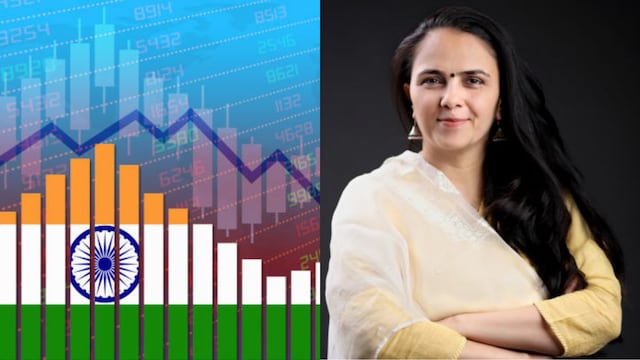SOURCE : NEW18 NEWS
Last Updated:May 18, 2025, 11:09 IST
On the sideline of the inaugural session of ICPP Annual Growth Conference 2025, Mishra discusses trade realignments, private investment challenges, etc.
Prachi Mishra (Director of ICPP and ex-member of IMF, RBI, and Goldman Sachs).
As global trade dynamics shift and India navigates through macroeconomic challenges, leading economist Prachi Mishra shares her insights on the emerging opportunities and economic transitions India must leverage.
Recommended Stories
Prachi has held key roles across top global and Indian institutions. She worked at the IMF in Washington, served as Managing Director and India Chief Economist at Goldman Sachs (2018–2020), and headed the Strategic Research Unit at RBI (2014–2017). Earlier, she was Senior Economist with India’s Finance Ministry and the PM’s Economic Advisory Council.
In a candid conversation on the sideline of the inaugural session of ICPP Annual Growth Conference 2025, she discusses trade realignments, private investment challenges, financial savings trends, and India’s long-term growth outlook.
Q: Ma’am, on protectionism – many countries are turning inward. What opportunities or risks do you see for India in this wave of protectionism?
Prachi Mishra: “Protectionism and shifting global trade rules are creating disruptions, but also opening up space for realignment in global value chains. India has a chance to position itself better,” she said.
She noted that while such changes may pose risks to exports and services in the short run, they also create space for India to step in and claim ground vacated by others. “There are a lot of opportunities because of the realignment that’s going on globally.”
Citing sectors like electronics and labor-intensive manufacturing, she emphasized that this is a good time for India to strengthen its place in the global production network, which could address both growth and employment concerns.
Q: Could you elaborate on specific opportunities you mentioned?
Mishra pointed to global trade’s resilience even after recent shocks. “We didn’t see a decline in global trade. There was reallocation instead.” She believes India can tap into this reallocation process and strengthen its role in sectors like electronics, engineering, and labor-intensive manufacturing.
Q: In your presentation, you mentioned challenges in private investment and the banking system. Could you elaborate?
“I don’t think I mentioned banking directly,” Mishra clarified. “But I did talk about declining net financial savings and structural shifts in household behavior.”
She pointed out that net financial savings in India have declined, though there has been a slight recovery. “We’re witnessing a structural transformation where Indian households are shifting away from traditional forms of saving.” Physical assets like real estate continue to dominate household portfolios, especially amid uncertainty.
“Household liabilities are going up. In many emerging markets, deposits form a large part of bank liabilities. So when savings patterns change, it affects banking structures too,” she added.
Q: Is the shift in savings a concern for the banking system’s lending capacity?
Mishra explained that the shift from traditional savings to newer financial instruments must accelerate. “Gross savings may be up, but net financial savings are down. Disentangling this is key. We need to encourage more financial savings to ensure banking stability.”
Q: With inflation cooling and RBI cutting rates, how do you see the balance between supporting growth and managing inflation expectations?
Calling it a “delicate balancing act,” Mishra said that central banks, including the RBI, must tread carefully. “Now that inflation is more manageable, and there are concerns about cyclical slowdown, the RBI has started easing and injecting liquidity. And there’s more to come.”
She noted that core inflation has come down significantly, supporting a more accommodative stance from the central bank.
Q: GDP growth projections for India are optimistic, but per capita income remains a concern. Your take?
“Per capita income has increased tenfold since 1980. That’s a remarkable success,” Mishra said. But she acknowledged that to become an advanced economy, India needs to sustain real growth of 6–7% over the next two decades.
She added, “We don’t need double-digit growth. Sustained 6–7% real growth can help us reach our long-term goals.”
Q: Finally, is the goal of becoming a developed economy by 2047 realistic?
“It’s ambitious but possible,” Mishra said. “With the right reforms, consistent investment in infrastructure, and careful macroeconomic management, we can get there.”
- First Published:
May 18, 2025, 11:05 IST







